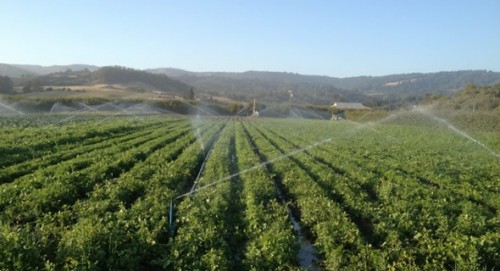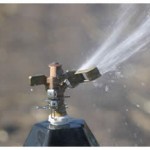 Limited, Precious Water
Limited, Precious Water
 Last week Juan called me, alarmed, because one of our main wells was not pumping water. We had just transplanted leeks and celery early that morning and temperatures were forecast in the mid-eighties. It felt as if someone pushed my Survival Instinct Alert button; at that moment, nothing was more important than to get the water flowing again. A worst case scenario would be that the pump motor or something in the well shaft got damaged; luckily this time the cause was only minor – just a burned-out fuse. It was a stark reminder, however, of how fragile our entire farming system is. We have grown foolishly accustomed to water that is available whenever we want it. The vast agricultural landscapes of California should remind everyone that water is our single most precious commodity. Our ability to manipulate it by pumping, damming, storing and rerouting it has allowed us to convert an otherwise arid landscape into a highly-populated, abundant food-producing region. Water, not oil, is what allows us to farm along these narrow strips of precious fertile soil hugging the Pacific coast. We live on borrowed time as we pump water from our rivers and underground aquifers to grow crops that wouldn’t survive here otherwise. Water conservation is essential if we want to preserve agriculture.
Last week Juan called me, alarmed, because one of our main wells was not pumping water. We had just transplanted leeks and celery early that morning and temperatures were forecast in the mid-eighties. It felt as if someone pushed my Survival Instinct Alert button; at that moment, nothing was more important than to get the water flowing again. A worst case scenario would be that the pump motor or something in the well shaft got damaged; luckily this time the cause was only minor – just a burned-out fuse. It was a stark reminder, however, of how fragile our entire farming system is. We have grown foolishly accustomed to water that is available whenever we want it. The vast agricultural landscapes of California should remind everyone that water is our single most precious commodity. Our ability to manipulate it by pumping, damming, storing and rerouting it has allowed us to convert an otherwise arid landscape into a highly-populated, abundant food-producing region. Water, not oil, is what allows us to farm along these narrow strips of precious fertile soil hugging the Pacific coast. We live on borrowed time as we pump water from our rivers and underground aquifers to grow crops that wouldn’t survive here otherwise. Water conservation is essential if we want to preserve agriculture.
Every season we grow more than 50 different crops, and now that most of our spring plantings are in the ground, watering is a big job. Knowing when and how much water to apply to each crop is both an art and a science. So many variables to consider, such as soil type, specific crop requirements, delivery systems and weather patterns. Water is pumped from wells – some at rates of 200-300 gallons per minute – through an intricate system of tanks, pumps, pipes, hoses, sprinklers and valves, to virtually every plant in each field. We average putting about an inch of water on every crop per week, although requirements vary from crop to crop. For example, spinach may need more but green beans much less. Also, a mature crop will need more water less frequently, whereas a recently planted crop needs less water more frequently. Cool weather crops such as broccoli, cauliflower, lettuce, and most leafy greens, like to be irrigated with above-ground movable aluminum pipe sprinklers, while crops such as strawberries, tomatoes, peppers, squash, cucumbers, and eggplants we drip irrigate. A (very) few crops we don’t irrigate at all, such as our dry-farmed tomatoes and our established Pippin apple orchards.
With the help of a USDA grant, we are evaluating how new technologies for both drip and sprinkler irrigation can help reduce our current water budget. According to our records, last year we used approximately 62 acre-feet of water to raise our crops. Imagine a football field (an acre is only slightly smaller) covered 62 feet high with water. That’s a lot of water! More than 80 percent of our water for the farm comes from groundwater. The rest comes from rainwater collected in ponds.
Since the 1850s, when the first settlers moved into the area and began to farm, agricultural development has expanded from potatoes, grains, apples, and a variety of truck crops to a high value, predominantly berry production system. Today, about half (35,000 acres) of the basin is in irrigated agriculture. Over-pumping concerns were already identified back in the ’50s, and today everybody is in agreement that the basin is over-drafted, causing saltwater intrusion along the coastal areas where land is most intensely farmed.
Over the last few years, the Pajaro Valley (where our farm is located) has become a battleground on the issue of water, creating deep rifts and mistrust among many members of the community. It is increasingly important to educate the public about the decisions that need to be made and actions that must be taken, in order to prevent special interests from calling the shots and squandering this precious resource for short-term monetary gain. If farming is to survive we have to adopt water saving technologies, implement water conserving practices, and promote watershed-based policies that manage water resources equitably for all.
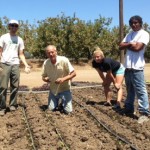 County Supervisor Kaputt working in Live Earth Farm’s Fields
County Supervisor Kaputt working in Live Earth Farm’s Fields
Last week we had an unusual visitor. Santa Cruz County Supervisor Greg Kaputt spent two days working with us in the fields. He arrived on Thursday at 9:00 AM and didn’t hesitate to jump right in to work side-by side with our field crew. First he worked with Noah and Laura picking Cherry Tomatoes, Peppers, and Beets, and then sorted Poblano Peppers with Angeles, Jenny, and Eva.

Santa Cruz County Supervisor Greg Kapput (center) in the field with FoodWhat?!
On Friday he spent the entire day with the “Food What”!? teens. First planting insectary hedgerows along the edges of our fields (a total of almost 1000 feet), and later in the day weeding a patch of Italian Parsley and planting a block of Basil.
Supervisor Kapput has his roots here in Watsonville. He sat on the City Council for several years and is an outspoken supporter of Agriculture and Farming in the Pajaro Valley. He shared his experience as an elected official and the projects and responsibilities he currently is engaged in. A good amount of his time is spent dealing with a myriad of issues ranging from public safety to the county budget, to clearing the Pajaro Riverbed to making sure potholes on roads in his district are fixed.
He said he hadn’t had his hands in the dirt for quite some time, but vividly remembers his summers working in the fields cutting lettuce and how hard that was for him. He was surprised by Live Earth Farm’s diversity of both crops and people working here. He was especially interested in the farm’s Community based business model working side-by-side with the Discovery Program to teach youth, hands-on, the value of healthy food and sustainable farming.
Supervisor Kaputt is known to engage at the grassroots level, and I admire that he took the opportunity during his summer break to spend some time on our farm to experience a slice of what, in my mind, is fundamental to the health of Santa Cruz County – its Agricultural Economy.

FoodWhat?! teen with Corno de Toro peppers
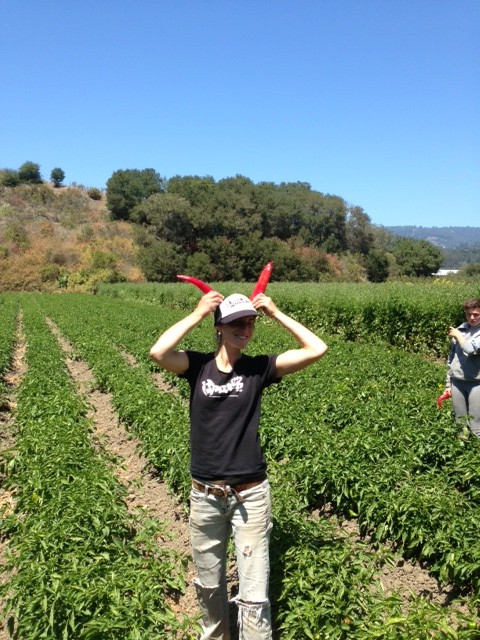
FoodWhat?! teen with Corno de Toro peppers
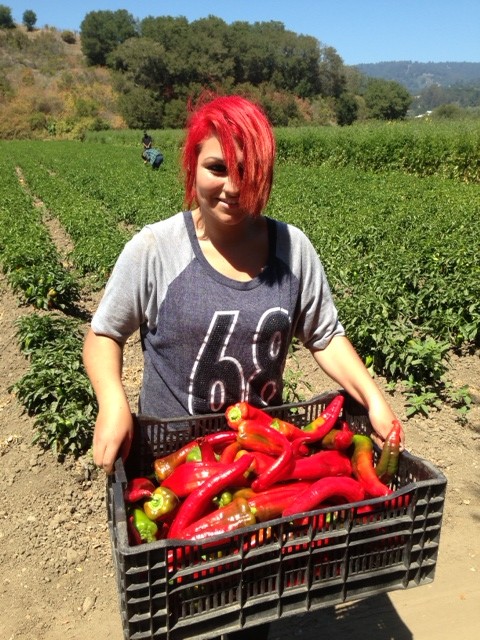
Part of the day’s pepper harvest.
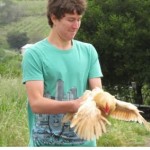 A Bittersweet Moment
A Bittersweet Moment
 Our son David just turned 18 in May, is graduating from Mt. Madonna High school this week, and is off to college by the end of summer. I cant deny feeling a bit emotional about it, seeing David all of a sudden as a mature young adult taking flight, leaving the nest. Watching him on stage for his final performance of the Ramayana — one of the great Indian epics his school has been performing every year since he started preschool 13 years ago (the immortal tale of Shri Rama that teaches us the values of devotion, duty, relationship, dharma and karma) — it struck me how true it is that it takes a village to raise a child. Not just a village, it’s more like an entire city contributed to his upbringing and unfolding maturity over the years.
Our son David just turned 18 in May, is graduating from Mt. Madonna High school this week, and is off to college by the end of summer. I cant deny feeling a bit emotional about it, seeing David all of a sudden as a mature young adult taking flight, leaving the nest. Watching him on stage for his final performance of the Ramayana — one of the great Indian epics his school has been performing every year since he started preschool 13 years ago (the immortal tale of Shri Rama that teaches us the values of devotion, duty, relationship, dharma and karma) — it struck me how true it is that it takes a village to raise a child. Not just a village, it’s more like an entire city contributed to his upbringing and unfolding maturity over the years.
I don’t expect him to take over the farm anytime soon, but I know he draws inspiration from having grown up on a farm. In his college application he wrote, “…organic farming has always been a part of my life. I believe everyone should have access to healthy sustainably grown food like I do. I like to go to a school that prepares me to build food systems that prevent hunger, malnutrition, and obesity.” The farm, his home for nearly 18 years, has nurtured and planted a seed in him, a seed that tells a rich story of a boy growing into a young man, one who now is ready to leave home and test new fields and soil content, to start his own plantings.
 David was barely walking when we started Live Earth Farm, a place in nature surrounded by a diverse community of animals, plants, and people. The farms fields and open spaces became his playground; collecting sticks and stones, digging in the soil, playing with the chickens, goats, dogs and cats, climbing trees to reach that perfectly-ripe sweet fruit, or just hiding in the shade of his favorite climbing tree were simple but enriching activities. I vividly remember how, in spring, he would disappear into cover-cropped fields taller than he was for hours, alone or with his friends, slashing with sticks and make-believe swords at the tall fava beans.
David was barely walking when we started Live Earth Farm, a place in nature surrounded by a diverse community of animals, plants, and people. The farms fields and open spaces became his playground; collecting sticks and stones, digging in the soil, playing with the chickens, goats, dogs and cats, climbing trees to reach that perfectly-ripe sweet fruit, or just hiding in the shade of his favorite climbing tree were simple but enriching activities. I vividly remember how, in spring, he would disappear into cover-cropped fields taller than he was for hours, alone or with his friends, slashing with sticks and make-believe swords at the tall fava beans.
 He has also experienced the physical work involved in farming, doing farm chores, working summers and seeing Dad returning late from the fields often exhausted from seemingly endless work and little time to play. He understands the harsh realities of farming; the risks caused by unpredictable weather, pests, fires, mechanical equipment breakdowns… all of which cause damage and loss on the farm. He understands the seasonality of food, the cycles of planting, growing, harvesting, celebrating and resting. Every day, when we prepare and share meals, he gets to experience how crops only recently growing in our fields are transformed into a nourishing meal. In our family, sharing meals is an important daily ritual, a time to slow down and simply enjoy and be grateful for being together.
He has also experienced the physical work involved in farming, doing farm chores, working summers and seeing Dad returning late from the fields often exhausted from seemingly endless work and little time to play. He understands the harsh realities of farming; the risks caused by unpredictable weather, pests, fires, mechanical equipment breakdowns… all of which cause damage and loss on the farm. He understands the seasonality of food, the cycles of planting, growing, harvesting, celebrating and resting. Every day, when we prepare and share meals, he gets to experience how crops only recently growing in our fields are transformed into a nourishing meal. In our family, sharing meals is an important daily ritual, a time to slow down and simply enjoy and be grateful for being together.
 The farm is intuitively a part of him, his body has been nurtured by food that came from the land, and has lived many seasons through his four senses. Soon he’ll be off to explore and discover his passion, his inner compass seeking out direction in the challenging opportunities of our time, inviting him to raise his voice, to engage in and construct communities for a world that is more just, more healthy, and more democratic… and (I am sure) in which sustainable agriculture and farming families form a fundamental part of a better future. The seeds planted in him carry farming values of respect, courage, perseverance, mutual assistance, and love, lots of love. Love for friends, family, and community, love for nature, love of agriculture, and most importantly – love of life. David is ready to graduate, to leave his school and home to explore the world. It is a blessing for Constance and I to feel that by letting go we are invited to witness and walk with him on his next journey.
The farm is intuitively a part of him, his body has been nurtured by food that came from the land, and has lived many seasons through his four senses. Soon he’ll be off to explore and discover his passion, his inner compass seeking out direction in the challenging opportunities of our time, inviting him to raise his voice, to engage in and construct communities for a world that is more just, more healthy, and more democratic… and (I am sure) in which sustainable agriculture and farming families form a fundamental part of a better future. The seeds planted in him carry farming values of respect, courage, perseverance, mutual assistance, and love, lots of love. Love for friends, family, and community, love for nature, love of agriculture, and most importantly – love of life. David is ready to graduate, to leave his school and home to explore the world. It is a blessing for Constance and I to feel that by letting go we are invited to witness and walk with him on his next journey.
 One for the Record Books
One for the Record Books
We always love getting pictures of your children and Live Earth Farm’s produce to share with everyone in the newsletter. Here’s the latest — from our very own Jessica Ridgeway, director of LEFDP. Her new baby, Current, shares the stage with a truly massive chard leaf, and her older sister, Ophelia.
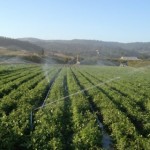 Living on the Water’s “Edge”
Living on the Water’s “Edge”
Last week while accompanying our son to the east coast to start his journey as a college student, we saw large tracks of corn and soybeans severely stunted from this year’s record-breaking drought. I am so used to irrigation agriculture that I had to remind myself that the vast majority of this country’s farmland is rain-fed, and therefor at the beck and call of nature’s caprices. Climate change will inevitably expose us to more such frequent climatic extremes and oblige us to rethink our current system of mono-cropping. The challenge will be to develop food systems that are more resilient by focusing on diversification, less fossil fuel dependency, optimum nutrition, and most importantly, create accessibility to food through diverse decentralized regional and local distribution networks. The idea of building local and regional foodsheds may still be in its infancy, however it is an exciting one; such a shift would result in consumers becoming more aware of where their food comes from, leading to more active involvement in building a more sustainable food supply in the long term.
Driving along the highway in Illinois and Indiana, looking at mile after mile of desiccated crops, I am relieved that our farm’s harvest does not directly rely on water falling from the sky. Most farms in the arid west, especially here in California, depend on stored water – either from man-made reservoirs or vast underground aquifers. Here in the Pajaro Valley, farms like ours all depend on groundwater, which has to be pumped from wells, some as deep as 500 feet or more. A failing water pump, on a hot day, will immediately bring us face to face with the essential importance of this life-giving resource. Knowing when and how much water to apply to a particular crop is both an art and a science. There are many variables to consider, such as soil type, specific crop requirements, delivery systems and weather patterns. To conserve as much water as we can we use drip irrigation, mulching, and dry farming. An intricate system of tanks, pumps, pipes, hoses, sprinklers and valves transport this limited and increasingly costly resource to our crops. On average, we have to put about an inch of water on our crops every week. Water requirements vary from crop to crop, for example spinach may need more but green beans much less. Also, a mature crop will need more water less frequently whereas a recently planted crop needs less water more frequently.
At the current rate, more groundwater is being extracted from our aquifer than is being replenished; in some cases along the coast, this overdrafting of groundwater is causing saltwater intrusion. We are living on borrowed time as we pump unsustainable amounts of water. It may seem surprising to some, but over 80% of water used in California is used in Agriculture. Conserving water is everyone’s responsibility, especially we farmers who are using the bulk of it. We will need to come up with ways to conserve more or even grow less or different crops to lower our current consumption.
– Tom
 Technology to the Rescue
Technology to the Rescue
Overwhelmed with the amount of harvesting going on at the moment it’s been tricky to stay on top of propagation and planting schedules. Most of our crops are raised from seed, grown into seedlings and hand transplanted when they are large enough to thrive under the more challenging field conditions. The moment a seed is sown the clock starts ticking. Field preparations need to be timed so as to overlap with the maturity of the seedlings which then need to be planted on a specific schedule. Lately we have been falling behind on our fall and winter plantings and needed serious help. Luckily, I held on to a seedling transplanter I bought a few years ago and was about to sell it since it was ill suited for our small diversified farming operation. The entire implement was too heavy for even our largest tractor and too long to make the tight turns at the end of our fields. This particular transplanter was best adapted for perfectly level fields where rows are long and soils are light. But as it often happens, necessity triggers the most creative solutions and we changed the set up so as to only plant single rows instead of double rows, which ended up cutting the length and weight of the implement in half. We suddenly were able to plant what would normally take 16 people to plant in two days only 5 people in half the time. It was a welcome relief, not only on our bodies but it also saved us from falling behind on our planting successions and harvests later in the season. I am glad that I am by nature one who resists throwing away or selling anything here on the farm that may still have a potential future use, even if that use may not yet be identified. It sure paid off this time.
– Tom
 A Dynamic Struggle
A Dynamic Struggle
If you think farming is mostly a peaceful one-with-nature experience, I can assure you, when it comes to weeds it is a battle. Weeds can’t be eradicated since they are much better at what they do than their domesticated cousins we harvest for food. Here on the farm it takes countless hours to control them. We have developed a number of strategies over the years and employ an assortment of handy “weapons”.
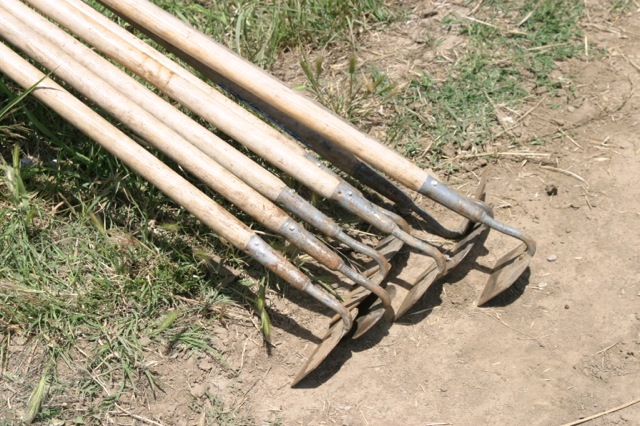
The most low-tech device is the common hoe, of which my favorite is the wheel hoe. It has two-handles with a wheel in the middle and a swiveling stirrup shaped blade. One walks behind it, pushing the wheel hoe allowing the blade to slide and slice just below the surface of the soil effectively decapitating the weeds in its path.
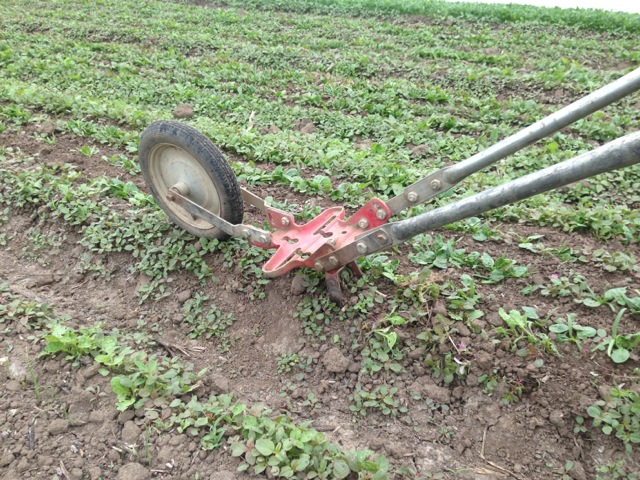
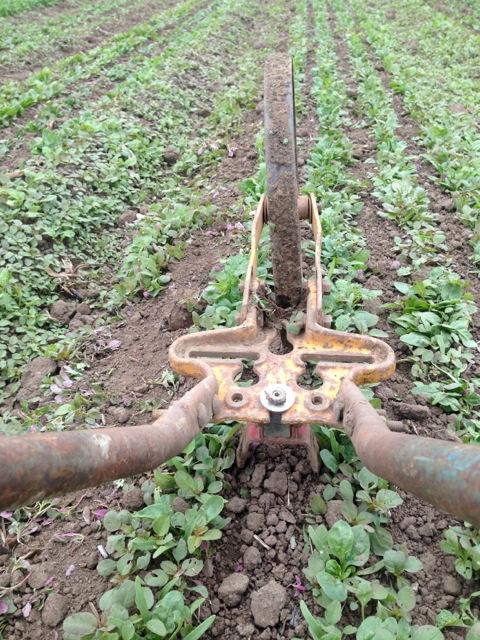
The primary reason to invest in farming equipment is to reduce the time and physical exertion required for many of our daily field tasks. When it comes to weeding with a tractor it requires a specialized assortment of different knives, shovels and discs set up in such a way that they cut, remove and throw soil all at the same time, just inches away from the crop that is growing. Tractor cultivating is almost an art form that takes years of experience. If the timing of soil moisture and the growth stage of both crop and weeds are just right, we can cultivate everything mechanically and avoid the more time consuming and arduous task of hoeing and weeding by hand.
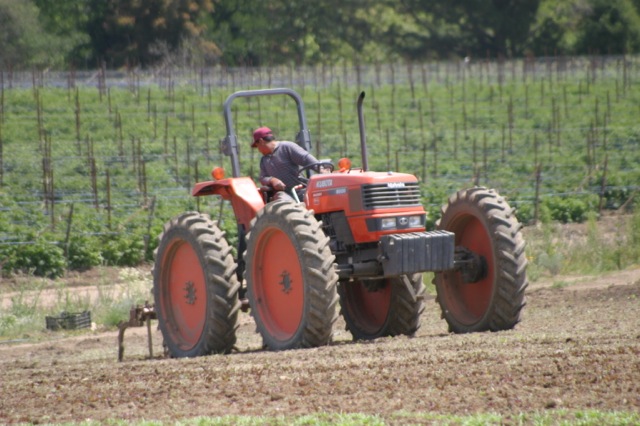
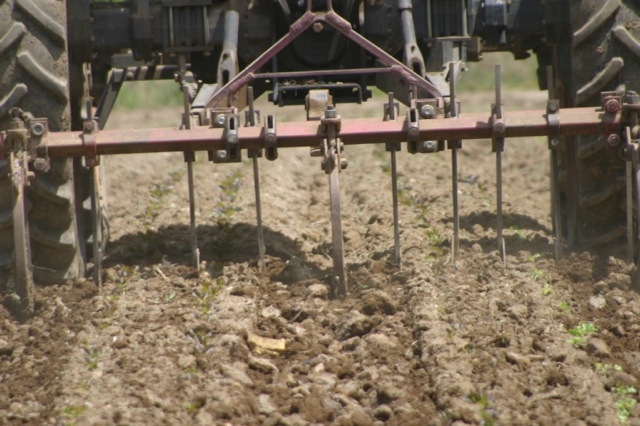
The most impressive weed-fighting tool in our arsenal is the fire spewing flame weeder mounted on the back of a tractor. It uses propane gas to activate four torches, which will flame the entire surface area of two planting beds. We use it to control weeds in carrots, which usually take longer to germinate giving us a chance to control the weeds before the carrots emerge.
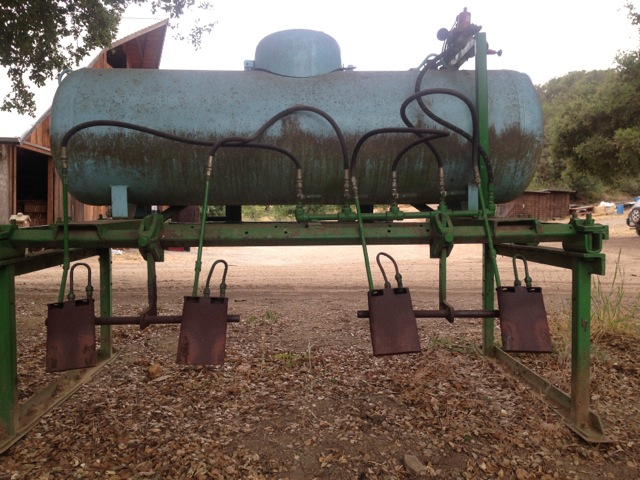
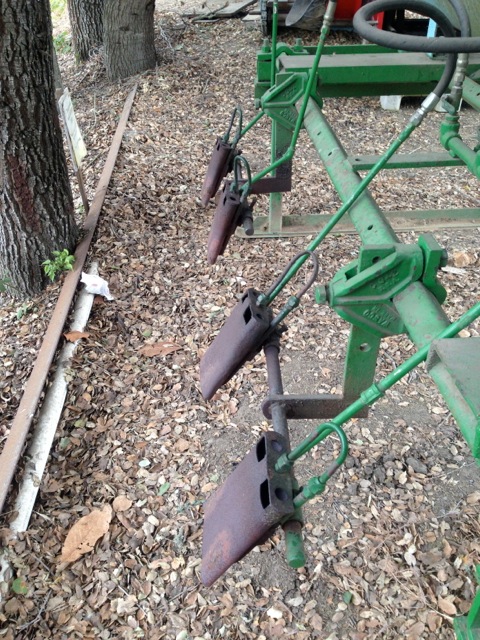
Timing is critical when using a flame weeder. Waiting too long means the carrots will have germinated and we run the risk of burning the carrots with the weeds. This happened to us a couple of weeks ago when a freshly sown patch of carrots decided to germinate on a Sunday, a little earlier than we anticipated. When on Monday morning we decided to flame, the heat of the burners killed the weeds but also the carrot seedlings which were right on the surface of the soil about to push through. As a result, we’ll soon experience a 3-4 week gap in our carrot harvest. Ouch!
To avoid high crop production costs, weeding requires vigilance to effectively determine when weed control is needed in each crop, choosing the best cultivation tools for each crop, and harmonizing weed control tactics with other cropping practices such as irrigation, fertilization, and insect/disease management. Typically we achieve the best results through a combination of hand and mechanical cultivation.
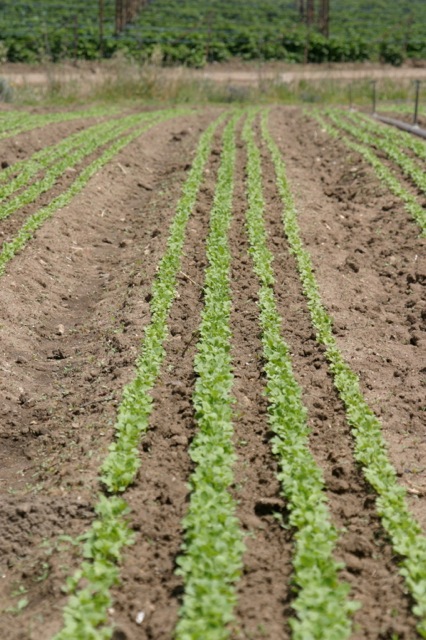
There are times of course when the nature and wildlife proponent in me looks beyond the more adversarial relationship the farmer in me has with weeds, and I see the benefits they have in the farm landscape. Weeds provide habitat and food for beneficial insects, birds and animals. They prevent erosion and contribute organic matter. Many have medicinal (plantain) and nutritional (purslane, lamb’s-quarters) value, and play an intricate part in the web of life here on the farm.
Controlling weeds is like Life itself – it’s a balancing act we constantly struggle to maintain.
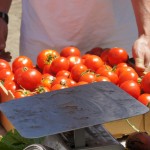 The Farm – A place to taste and inspire
The Farm – A place to taste and inspire
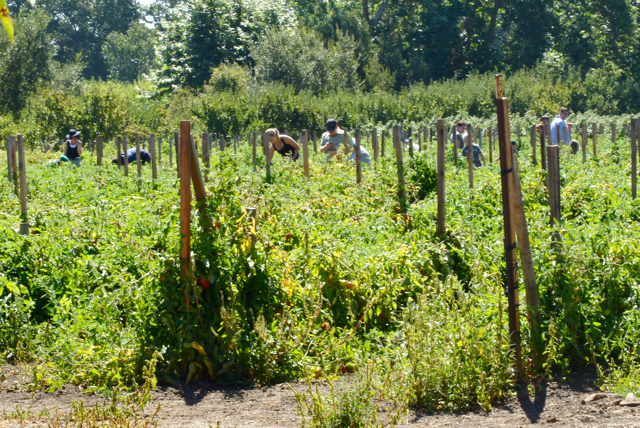
Sammy, his face stained from picking and eating raspberries, came up to me during last Saturday’s Tomato U-Harvest, offering me to taste a berry from a full basket he just picked. “It is a lot of work to pick these”, he commented. I agreed, as I popped a berry in my mouth. “But worth it – they are delicious.”

He then pointed to a stack of boxes filled with tomatoes sitting in the shade of an old Newton Apple tree. “We already have five boxes,” he said excitedly. “Wow, that’s a lot,” I agreed again, trying to spot his parents somewhere among the crowd of pickers. Sammy and his family like to visit the farm and attend our regular community celebrations and farm days. I remember during our last U-Harvest, Sammy didn’t seem to mind the heat while helping his dad harvest Apricots.
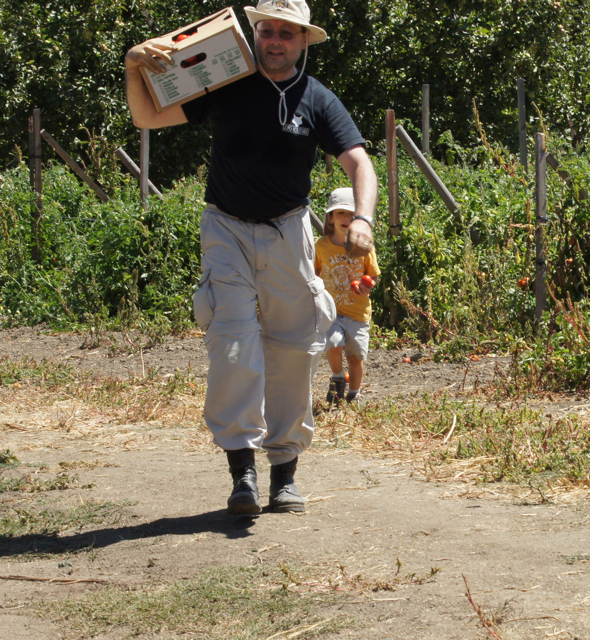
It makes me happy to see children running around, exploring the fields, playing with the farm dogs, the goats and chickens. In today’s Fast Food culture we have gotten so removed from the places and soil where our food is grown that often we are suffering from sensorial deprivation; our senses to touch, smell, and taste food are no longer trained to give us a deeper understanding of the environment, ourselves, and the larger community of life we belong to. Why should any child choose to eat an apple if the only choice is a red or green, waxed and tasteless one sitting next to a bag of “Cheetos”?
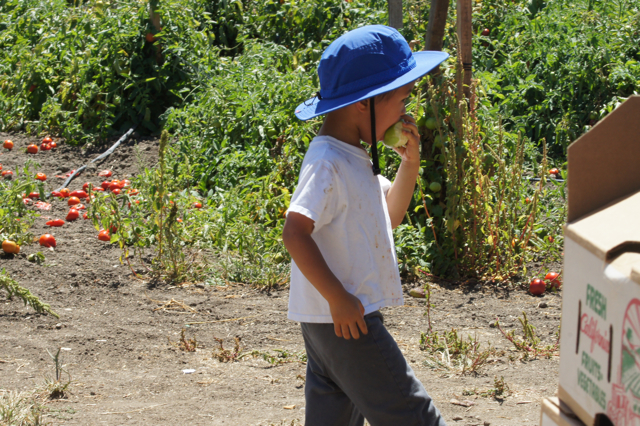
For 18 years now we have focused on offering sustainably grown, healthy and tasty food, and open the farm to our community as a place for teaching about where our food really comes from and learning about the interconnectedness between humans and the larger natural ecosystem. When children like Sammy come to the farm they can engage their senses to discover the pleasures of real food.
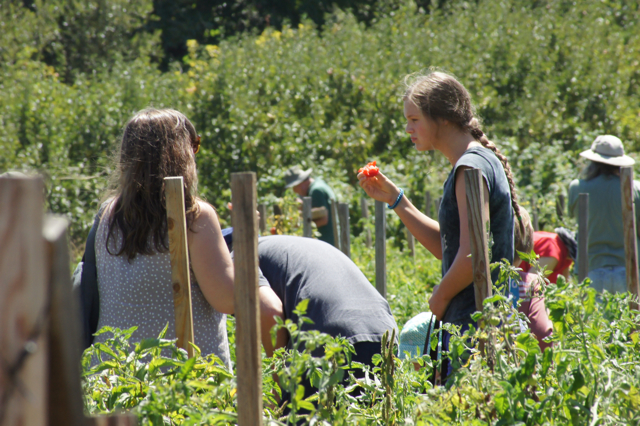
The Live Earth Farm’s Discovery Program has expanded our ability to reach out to children and youth in this county by turning the Farm into a classroom to teach field-to-fork environmental stewardship. Last year over 1400 children and young adults came to the farm, attending farm tours, workshops, summer-camps, and seasonal celebrations. In addition we have on-going programs with the Santa Cruz Montessori School and recently with “Food What?!”, a county youth program organized by UCSC’s Life Lab Program.
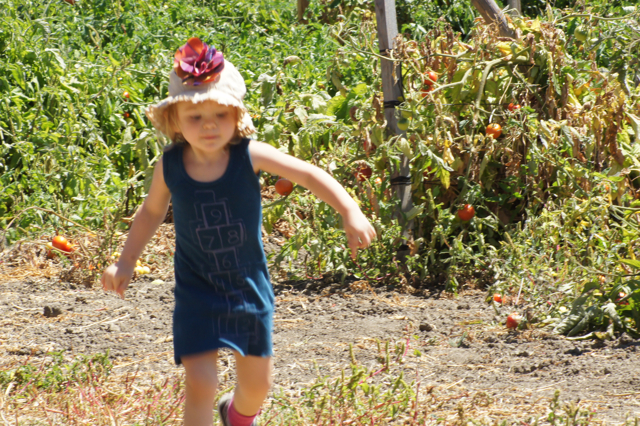
Your commitment and financial support have been essential to strengthen and expand the farm’s educational efforts. Our Annual Fundraiser “SLICE” on September 14th is a great opportunity to show your continued support. If you haven’t done so yet, get your tickets now for one of the farm’s more memorable annual events. “SLICE” will be a unique in-the-Apple-orchard dinner, with wonderful food and entertainment.
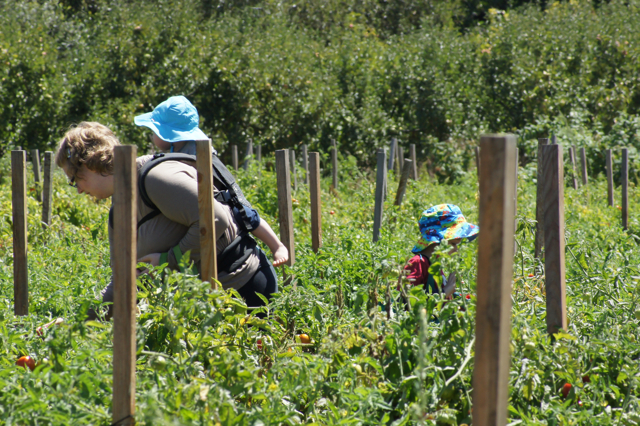
All of the proceeds will go to inspire our next generation of children and youth about how healthy farms and food lead directly to making healthier choices in their own lives and the community they live in. Thanks for your support and I hope you can join us!
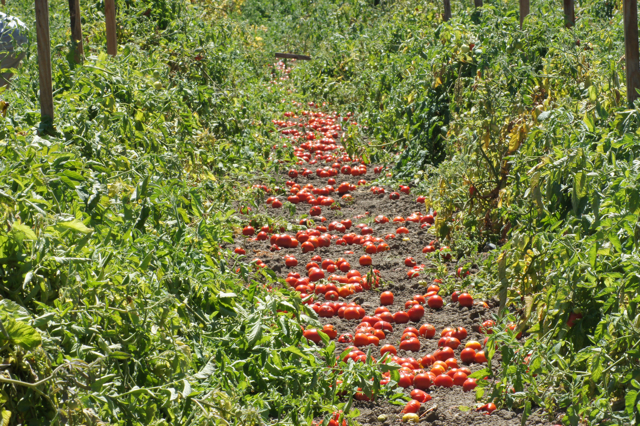
 Food Safety at What Cost?
Food Safety at What Cost?
Holy compost and manure!!!
It’s holy to me and many of my fellow farmers but for many who have lost sight of the vital connection between their daily lives and farming, organic waste is seen as a problem that is dirty and dangerous – not a vital ingredient to build healthy soils and grow nourishing food.
The Food and Drug Administration (FDA) under the newly passed Food Safety and Modernization Act is proposing regulations that would undermine uses of compost and manure currently approved under the National Organic Program. This new regulatory effort has been triggered by food-borne illnesses that have occurred in the last few years, most of them stemming from large-scale food operations.
Currently the proposed regulations seem to be driven more by food safety fear than sound science, leading to ‘sterile’ and ‘scorched-earth’ approaches to the problem. The FDA’s proposed regulations don’t recognize the importance of organic farming and conservation practices as a valuable contributor to reducing the risk of pathogens. Proposed regulations aimed at curtailing the use of compost and manures are based on misguided assumptions, striking at the heart of organic and sustainable farming practices helping to build healthy and fertile soils.
Farming by it’s very nature disturbs the soil, and it is imperative that we don’t loose the tools that help us farmers sustain a healthy balance between growing food and replenishing nutrients and organic matter to support the life and diversity of microorganism in the soil.

A pinch of the Farm’s rich, healthy soil.
Here on the farm we make our own compost by using carbon rich sawdust discarded by a local organic mushroom farm (after they harvest the mushrooms), mixed with organic chicken litter generated by an organic chicken operation down the road from us, and we also add our own vegetable scraps. The blend is moistened and turned many times as it heats up and allowed to go through a 6-8 month composting process transforming the ingredients into a wonderful rich chocolate-like material that has little to do with the initial organic materials we started with.

A couple of the Farm’s compost piles.
All organic matter composts, it’s a natural process in nature, however what seems simple and taken for granted at first sight is very complex and difficult to comprehensively describe in this newsletter (there is plenty of literature on it however). The soils on the farm are an ecosystem alive with mammals (soil burrowing gophers and moles), reptiles (gopher snakes), amphibians (frogs and toads), worms, insects, bacteria and fungi.
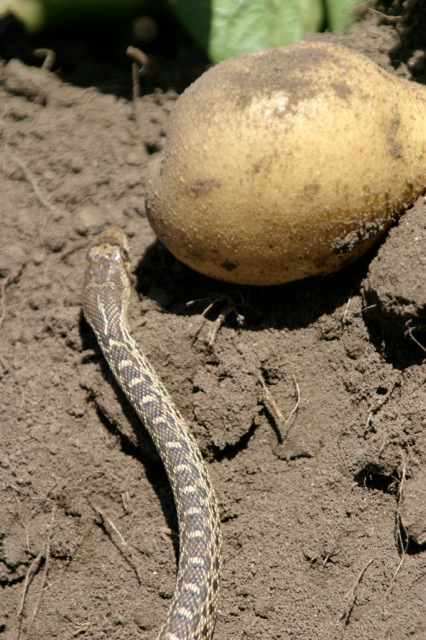
A young Gopher Snake in with the potatoes.
Soil fungi and bacteria break down dead plant and animal matter, making humus in the process and freeing up nutrients. There are billions upon billions of bacteria in the soil, and many plants have symbiotic relationships with both fungi and bacteria that live in and around roots. They deliver nutrients, especially nitrogen, and receive sugars from the roots in return. Many researchers agree that plants, similar to our own bodies, have immune systems that are stronger when a diverse interaction exists with animals, worms, bacteria, viruses, and fungi.
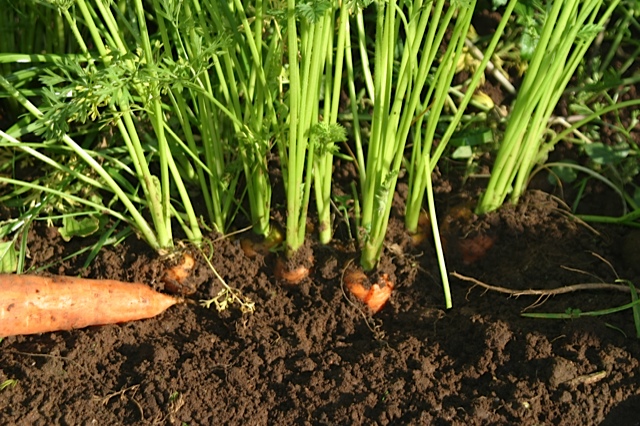
Carrots need healthy, nutrient rich. loamy soil to grow well.
Compost is applied to our fields every year to increase both organic matter and reinvigorate the population of microorganisms that directly contribute to an increase in productivity and healthier plant growth. Biologically active soils are also known to be more efficient at sequestering carbon dioxide by capturing carbon through growing plants and cycling them back into the soil.
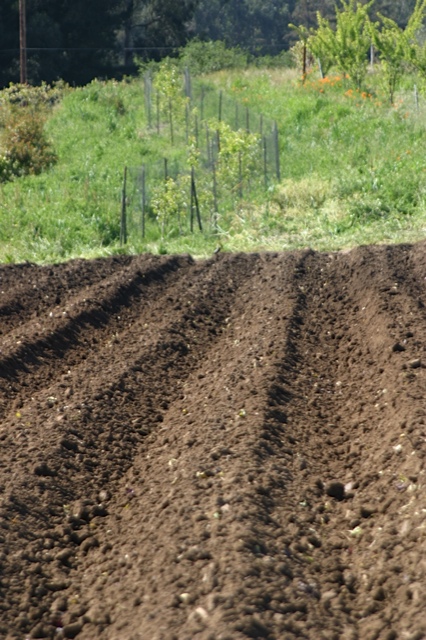
One of the Farm’s recently fertilized and plowed fields.
We are all responsible to ensure a safe food supply from field to our plates but it should not be at the cost of undermining ecologically sound farming practices.
I don’t do this very often but I ask you to please speak up. Everyone who receives this newsletter, please tell the FDA that their proposed regulations should align with the National Organic Program regulations, specifically when it comes to the use of compost and manure. We have until November 15th to submit comments, the link below will connect you to the website of The Wild Farm Alliance which has been actively raising awareness about this issue.
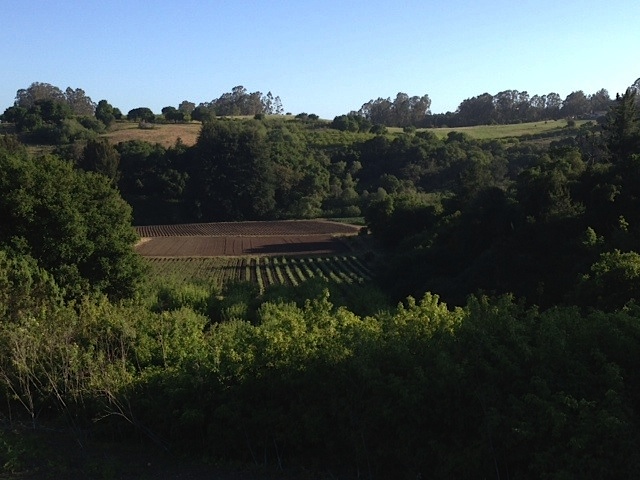
An overview of some of the Farm’s fields and orchards.
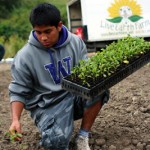 “FOOD, WHAT?!” – Inspiring and Helpful
“FOOD, WHAT?!” – Inspiring and Helpful
Our workload has ratcheted up another notch as summer-crops have started maturing. Green beans, peppers, and cherry tomatoes have been added to the weekly harvest list. The increasing number of tasks mimics the abundance in the field and since most of them are manual by nature, work often starts at dawn and sometimes doesn’t stop until dusk.
Growing fruits and vegetables relies mostly on manual labor, crops are hand-planted, hand-weeded, hand-pruned, hand-picked, hand-dug, hand-bunched, hand-sorted, hand-washed, hand-packed, and then hand-loaded on and off the delivery truck. That’s a lot of handling before and after a seed has metamorphosed into any of the dozen or so produce items in your weekly CSA share.

With all that manual workload you can imagine how welcome a helping hand is at this time of year here on the farm. The last 6 weeks we have enjoyed such help from a wonderful group of teens. Every Friday, at 9 o’clock in the morning, 20 youths from the “Food, What?!” program gather in a circle under the giant oak tree by the barn ready to take on the field tasks scheduled for that day. Planting, weeding or harvesting, these kids don’t shy away from working in the fields.
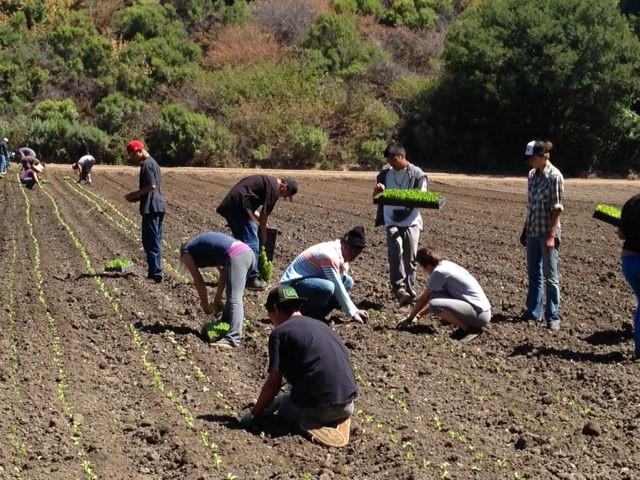
“Food, What?!” I like the name; it’s an important question, one that is at the core of our well-being, the question to understand our connection to food and where it comes from.
Both the Farm’s Discovery Program and “Food What!” share common goals of youth empowerment and farm-based education. On their website “Food What?!” is described as a “… youth empowerment and food justice program using food, through sustainable agriculture and health, as the vehicle for growing strong, healthy, and inspired teens. The program partners with low-income and at-risk youth to grow, cook, eat, and distribute healthy, sustainably raised food and address food justice issues in our community. Youth from Watsonville to Santa Cruz join the FoodWhat Crew through Spring Internships, Summer Jobs, Fall Business Management positions, and leading big community events. It’s an opportunity for youth to engage in leadership development, personal growth, and job training”.
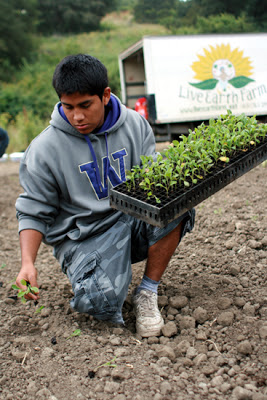
What is exciting and unique about this partnership between Live Earth Farm’s Discovery Program and “Food, What?!” is that the teens can engage in the operation of a real working farm, where they work side by side with 30 hardworking farm employees, experiencing literally from the ground up the fruits of their labor. Whether it’s getting the next succession of kale, lettuce or broccoli in the ground which involves planting thousands of seedlings in straight rows, cutting one hundred 24-count boxes of romaine lettuce, or weeding a 1 acre block of peppers.

At first these tasks sound simple, but once engaged many soon realize it’s not only the physical stamina but skilled hand and body movements and the mastery of a number of specialized tools that are required to do the job well. The teens come to realize that each crop is different, delicate and highly perishable. They come to understand that being a harvester requires different sets of techniques that need to be performed in a timely manner, with attention to quality under often physically taxing outdoor conditions.
Working with the group every Friday has been a real pleasure and a welcome help for the entire farm crew. This upcoming Friday we have planned harvesting potatoes, another big job we are thankful to get some help with.
Check out their website for a photo-essay, capturing a typical Friday at Live Earth Farm


